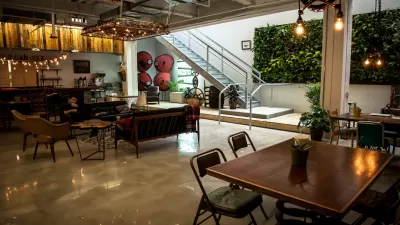The communal living opportunity for San Jose residents was made possible by the creation of an entirely new designation in the city's zoning code.

Sarah Holder reports on the biggest project yet from developer Starcity, an 18-story building with 803 units in Downtown San Jose, California. The catch: Starcity develops buildings for co-living arrangements, already completing seven projects in Los Angeles and San Francisco.
"In most Starcity buildings, renters get a furnished 130- to 220-square-foot bedroom and share a communal kitchen and living space," writes Holder. "In a [sic] addition to a “generous bathroom to room ratio,” the company touts a range of Millennial-friendly amenities, including an honor library, 'locally sourced foliage,' and Bob Ross painting nights. Rents range from $1,400 to $2,400 a month."
According to Holder, the development proposed for San Jose would be the world's largest co-living building in the world.
Holder parlays the discussion about the new Starcity project to discussions about Starcity's many contemporaries trying to make the old model of single-room occupancy hotels (SROs) new for the 21st century.
Starcity considers itself distinct from SROs, however, in how it uses each building, as Curbed SF reported: "95 percent of the usable square footage in an SRO is renters’ rooms, with the remaining five percent mostly hallways. By comparison, a Starcity building is about 65 percent bedrooms, and 20 percent of the building is dedicated to ‘communal spaces and kitchens.’” And renters commit to living there longer than the transient characters who once bunked at week-to-week boarding houses…
As noted by Holder, the new model for communal living also breaks the mold of most zoning codes, including in San Jose. Starcity had to work with the city to create an entirely new form of land use: "co-living." While Starcity's previous developments used zoning classifications already in existence in those cities, the San Jose experience offered a chance to be the first-ever use of the co-living zoning classification, according to Holder.
FULL STORY: The Largest Co-Living Building in the World Is Coming to San Jose

Maui's Vacation Rental Debate Turns Ugly
Verbal attacks, misinformation campaigns and fistfights plague a high-stakes debate to convert thousands of vacation rentals into long-term housing.

Planetizen Federal Action Tracker
A weekly monitor of how Trump’s orders and actions are impacting planners and planning in America.

In Urban Planning, AI Prompting Could be the New Design Thinking
Creativity has long been key to great urban design. What if we see AI as our new creative partner?

King County Supportive Housing Program Offers Hope for Unhoused Residents
The county is taking a ‘Housing First’ approach that prioritizes getting people into housing, then offering wraparound supportive services.

Researchers Use AI to Get Clearer Picture of US Housing
Analysts are using artificial intelligence to supercharge their research by allowing them to comb through data faster. Though these AI tools can be error prone, they save time and housing researchers are optimistic about the future.

Making Shared Micromobility More Inclusive
Cities and shared mobility system operators can do more to include people with disabilities in planning and operations, per a new report.
Urban Design for Planners 1: Software Tools
This six-course series explores essential urban design concepts using open source software and equips planners with the tools they need to participate fully in the urban design process.
Planning for Universal Design
Learn the tools for implementing Universal Design in planning regulations.
planning NEXT
Appalachian Highlands Housing Partners
Mpact (founded as Rail~Volution)
City of Camden Redevelopment Agency
City of Astoria
City of Portland
City of Laramie





























